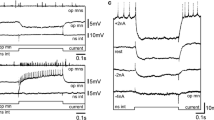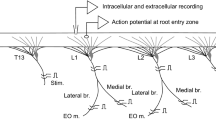Summary
Control of the crayfish uropod motoneurons by the unilateral-type local non-spiking interneurons (LNSNs) in the terminal (sixth) abdominal ganglion was studied with intracellular recording and current injection.
-
1.
Current injected into LNSNs affected the spike activity of uropod motoneurons in a graded manner. The effects depended on both the duration and the intensity of current pulses.
-
2.
Simultaneous intracellular recordings from an LNSN and an opener motoneuron showed that LNSNs could change the motoneuron membrane potential by their own membrane potential change without generating spikes.
-
3.
In fifty-nine cases, we penetrated LNSNs which affected uropod motoneurons bidirectionally. Hyperpolarization of 23 LNSNs decreased and that of other 36 LNSNs increased the spontaneous discharge rate of an identified reductor exopodite motoneuron (Red MN) No. 1. Depolarization had the opposite effect in either case.
-
4.
It is suggested that at least one chemical synapse should be intercalated between the LNSN and the motoneuron. although whether their connection is monosynaptic or not still remains open to future study.
-
5.
Twenty-four penetrated LNSNs co-actively controlled the synergistic set of motoneurons. Other 23 LNSNs also controlled the antagonistic set in addition to the synergistic set of motoneurons in a reciprocal way, and other 21 LNSNs in a co-activating way.
-
6.
The possible role of unilateral-type LNSNs in the motor control, especially in the non-rhythmical, episodic movement such as uropod steering, is discussed.
Similar content being viewed by others
Abbreviations
- LNSN :
-
local non-spiking interneuron
- Red MN :
-
reductor exopodite motoneuron
- Add MN :
-
adductor exopodite motoneuron
- Abd Ex :
-
abductor exopodite
- p.s.p. :
-
postsynaptic potential
References
Burrows M (1979a) Synaptic potentials effect the release of transmitter from locust nonspiking interneurons. Science 204:81–83
Burrows M (1979b) Graded synaptic interactions between local pre-motor interneurones of the locust. J Neurophysiol 42:1108–1123
Burrows M (1980) The control of sets of motoneurones by local interneurones in the locust. J Physiol (Lond) 298:213–233
Burrows M (1981) Local interneurones in insects. In: Roberts A, Bush BMH (eds) Neurones without impulses. Cambridge University Press, Cambridge, pp 199–221
Burrows M, Siegler MVS (1976) Transmission without spikes between locust interneurones and motoneurones. Nature 262:222–224
Burrows M, Siegler MVS (1978) Graded synaptic transmission between local interneurones and motor neurones in the metathoracic ganglion of the locust. J Physiol (Lond) 285:231–255
Fain GL (1981) Integration by spikeless neurones in the retina. In: Roberts A, Bush BMH (eds) Neurones without impulses. Cambridge University Press, Cambridge, pp 29–59
Hardy WB (1929) Note on the central nervous system of the crayfish. J Physiol (Lond) 67:166–168
Harreveld A Van (1936) A physiological solution for freshwater crustaceans. Proc Soc Exp Biol Med 34:428–432
Heitler WJ, Pearson KG (1980) Non-spiking interactions and local interneurones in the central pattern generator of the crayfish swimmeret system. Brain Res 187:206–211
Hisada M, Takahata M, Nagayama T (1984) Structure and output connection of local non-spiking interneurons in crayfish. Zool Sci 1:41–49
Larimer JL, Kennedy D (1969) Innervation patterns of fast and slow muscle in the uropods of crayfish. J Exp Biol 51:119–133
Mendelson M (1971) Oscillator neurons in crustacean ganglia. Science 171:1170–1173
Nagayama T, Takahata M, Hisada M (1983) Local spikeless interaction of motoneuron dendrites in the crayfishProcambarus clarkii Girard. J Comp Physiol 152:335–345
Pearson KG (1979) Local neurons and local interactions in the nervous system of invertebrates. In: Schmitt FO, Worden FG (eds) The neurosciences, fourth study program. MIT Press, Cambridge MA, pp 145–157
Pearson KG, Fourtner CR (1975) Nonspiking interneurons in walking system of the cockroach. J Neurophysiol 88:33–52
Rall W (1981) Functional aspects of neuronal geometry. In: Roberts A, Bush BMH (eds) Neurones without impulses. Cambride University Press, Cambridge, pp 223–254
Reichert H, Plummer MR, Hagiwara G, Roth RL, Wine JJ (1982) Local interneurons in the terminal abdominal ganglion of the crayfish. J Comp Physiol 149:145–162
Schmidt W (1915) Die Muskulatur vonAstacus fluviatilis (Potamobius astacus L.) Ein Beitrag zur Morphologie der Decapoden. Z Wiss Zool 113:165–251
Siegler MVS (1981a) Posture and history of movement determine membrane potential and synaptic events in nonspiking interneurons and motor neurons of the locust. J Neurophysiol 46:296–309
Siegler MVS (1981b) Postural changes alter synaptic interactions between nonspiking interneurons and motor neurons of the locust. J Neurophysiol 46:310–323
Siegler MVS, Burrows M (1979) The morphology of local nonspiking interneurones in the metathoracic ganglion of the locust. J Comp Neurol 183:121–148
Simmers AJ, Bush BMH (1980) Non-spiking neurones controlling ventilation in crabs. Brain Res 197:247–252
Stewart WW (1978) Functional connections between cells as revealed by dye-coupling with a highly fluorescent naphthalimide tracer. Cell 14:741–759
Takahata M, Nagayama T, Hisada M (1981a) Physiological and morphological characterization of anaxonic non-spiking interneurons in the crayfish motor control system. Brain Res 226:309–314
Takahata M, Yoshino M, Hisada M (1981b) The association of uropod steering with postural movement of the abdomen in crayfish. J Exp Biol 92:341–345
Takahata M, Komatsu H, Hisada M Positional orientation determined by the behavioural context inProcambarus clarkii Girard (Decapoda:Macrura). Behaviour (in press)
Wilkens LA, Wolfe GE (1974) A new electrode design for en passant recording, stimulation and intracellular dye injection. Comp Biochem Physiol 48:217–220
Yoshino M, Takahata M, Hisada M (1980) Statocyst control of the uropod movement in response to body rolling in crayfish. J Comp Physiol 139:243–250
Author information
Authors and Affiliations
Rights and permissions
About this article
Cite this article
Nagayama, T., Takahata, M. & Hisada, M. Functional characteristics of local non-spiking interneurons as the pre-motor elements in crayfish. J. Comp. Physiol. 154, 499–510 (1984). https://doi.org/10.1007/BF00610164
Accepted:
Issue Date:
DOI: https://doi.org/10.1007/BF00610164




